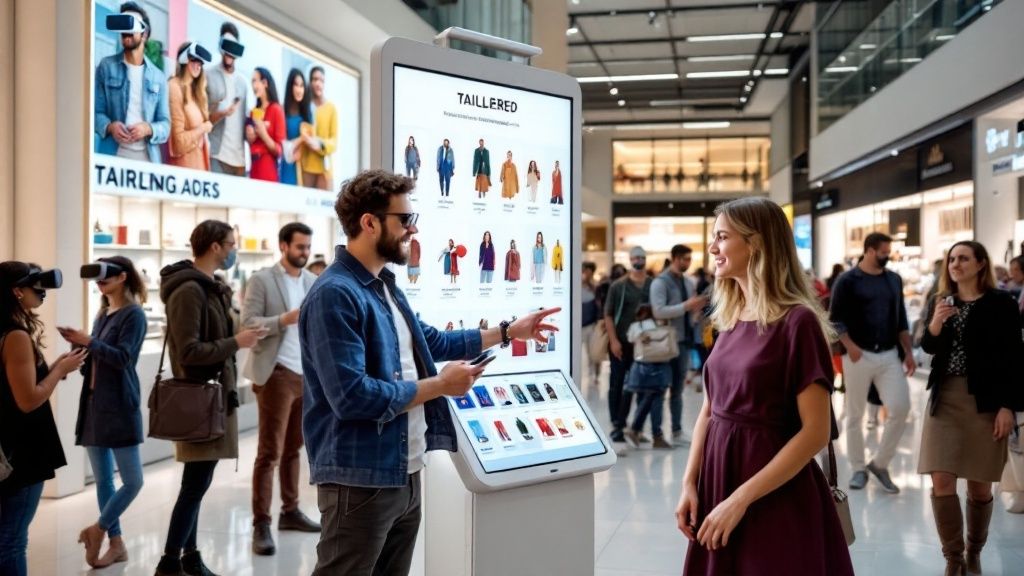Effective Social Media Marketing Strategies for 2024 and Beyond
November 21, 2024

Understanding Social Media Marketing Fundamentals

Social media marketing has become essential for any successful business. This means understanding its core principles is vital for connecting with your audience, building strong relationships, and seeing real results. These principles form the basis of campaigns that truly resonate with customers and help you reach your business goals. Let's explore these key elements to help you navigate the dynamic world of social media.
Defining Your Target Audience
Effective social media marketing begins with identifying your ideal customer. Consider who they are, their interests, needs, and challenges. Understanding where they spend their time online is also critical. For instance, a business targeting young adults might focus on platforms like TikTok and Instagram, while a company working with other businesses might concentrate on LinkedIn. This focused approach ensures you're directing your marketing efforts toward the most receptive group.
Choosing the Right Platforms
The sheer number of social media platforms available makes choosing the right ones crucial. Each platform has its own unique features and user demographics. Instagram is perfect for visually-rich content, while Twitter excels at real-time updates and conversations. LinkedIn is the platform for professional networking and business-to-business marketing. Therefore, carefully consider where your target audience spends their time and how each platform can contribute to your overall marketing plan. For more on building a strong marketing strategy, check out this helpful guide: Building a winning business marketing strategy.
Crafting Compelling Content
Content reigns supreme on social media. Creating high-quality, engaging content that resonates with your target audience is key to grabbing their attention and building a connection. This means offering a blend of informative, entertaining, and promotional material. Consider providing value through educational posts, behind-the-scenes looks, and user-generated content. Adding visuals like images and videos can greatly improve engagement. Compelling content, much like a captivating story, draws in followers and potential customers.
Building a Community
Social media isn't just about broadcasting your message—it's about cultivating a community around your brand. Engage with your followers, respond to comments and messages, and create a sense of belonging. This two-way communication strengthens relationships and fosters brand loyalty. Think of your social media presence as a virtual meeting place where customers can connect with your brand and each other. This community-building aspect is a powerful way to nurture a loyal customer base, which leads us to the importance of a well-defined content strategy.
Content Strategy Development
A successful social media presence requires more than just posting randomly. It requires a well-defined content strategy, acting as a roadmap for your social media efforts. This crucial step ensures your content resonates with your target audience, strengthens your brand, and drives the results you want. This involves planning, creating, and scheduling content aligned with your overall marketing goals. Just as an architect uses a blueprint, a solid content strategy is the foundation of your social media success.

Defining Content Pillars
Begin by identifying key themes or topics, often called content pillars, that are relevant to your brand and resonate with your audience. These pillars will form the backbone of your content calendar. For example, a fitness apparel brand might choose workout routines, healthy eating tips, and motivational stories as their content pillars. This framework helps create consistent, valuable content and establishes your brand as an authority.
Creating a Content Calendar
After establishing your content pillars, develop a content calendar. This schedule outlines what content will be published, where, and when. It's like an editorial calendar for your social media channels. Planning ahead ensures consistency and allows for strategic scheduling around important events or promotions. As a result, you can avoid last-minute rushes and maximize the impact of your content.
Content Format Diversification
While written content is important, varying your content formats can significantly increase engagement. Incorporate visuals like images and videos to cater to different preferences. Just as a balanced diet includes various nutrients, a diverse content mix keeps your audience interested. Consider using behind-the-scenes glimpses, user-generated content, and interactive polls to keep your content fresh and appealing.
Repurposing Existing Content
Creating quality content requires time and effort. Repurposing existing content is a smart strategy to make the most of your resources. A blog post can become a series of tweets, a webinar can be broken down into short, engaging videos for Instagram, and infographic data can be shared as individual image posts on Facebook. This expands your reach and extends the life of your valuable content. This strategic implementation builds a consistent, engaging, and impactful social media presence. This carefully cultivated online identity will attract new followers, build a sense of community, and drive your business objectives forward.
Platform-Specific Tactics
Effective social media marketing requires understanding that each platform operates differently and attracts unique users. This means tailoring your approach for each platform is key to maximizing reach and effectiveness. Just as a skilled craftsman uses different tools for different tasks, a smart marketer uses specific strategies for each social media channel. Let's explore how to optimize your presence on several popular platforms.
Facebook: Building Relationships and Driving Traffic
Facebook remains a cornerstone of social media marketing, with its huge user base and powerful advertising tools. Its focus on community makes it perfect for fostering relationships. Sharing engaging content, running contests, and responding promptly to comments and messages are all effective strategies. Furthermore, Facebook's robust advertising platform enables highly targeted campaigns, driving traffic to your website and generating leads. Using both organic and paid strategies is crucial for best results.
Instagram: Visual Storytelling and Influencer Marketing
Instagram, with its emphasis on visuals, provides a platform for captivating your audience with images and videos. It's a prime location for visual storytelling and showcasing your brand's personality. High-quality photography, striking graphics, and engaging video content are key. Influencer marketing is also important on Instagram. Partnering with relevant influencers can introduce your brand to a wider audience and build credibility. A carefully curated Instagram feed can significantly influence brand perception and drive customer engagement.
Twitter: Real-Time Updates and Engaging Conversations
Twitter's fast-paced, real-time nature makes it excellent for sharing updates, joining conversations, and building brand awareness. Sharing timely and relevant content, engaging with followers, and using relevant hashtags are essential. Twitter is also valuable for customer service, allowing you to address inquiries and resolve issues publicly. This transparency and responsiveness build trust. Using hashtags strategically and joining relevant conversations positions your brand as a thought leader.
LinkedIn: Professional Networking and B2B Marketing
LinkedIn, with its professional focus, is the top platform for business-to-business marketing and networking. Businesses connect with potential clients, partners, and employees here. Sharing industry insights, establishing thought leadership, and building relationships within your professional network are important. Sharing articles, participating in industry groups, and engaging with other professionals builds credibility and expands your reach. By actively participating on LinkedIn, you can establish yourself as a trusted authority and generate valuable leads, making it particularly effective for B2B businesses.
By understanding the nuances of each platform and adapting your strategies, you can connect with your target audience, build loyalty, and achieve your marketing objectives. This targeted approach ensures focused efforts and measurable results. Just as a conductor orchestrates different instruments for a harmonious symphony, a skilled marketer uses different social media platforms for a cohesive and impactful online presence.
Engagement and Community Building

Effective social media marketing involves more than just broadcasting your message; it's about nurturing a thriving online community. This means actively engaging with your audience and creating a space where they feel valued. Building this sense of belonging is critical for turning casual followers into loyal brand advocates. Let's explore techniques for building a vibrant community.
Responding to Comments and Messages
Responding to comments and messages is fundamental to community building. It shows your audience you're listening and value their input. Don't just acknowledge comments; respond thoughtfully and address any questions or concerns. This personal touch builds positive relationships and fosters trust.
Encouraging User-Generated Content
User-generated content (UGC) is powerful for building community and increasing brand authenticity. Encourage followers to share their experiences by creating branded hashtags or running contests. This provides valuable social proof and makes your followers feel like they're part of something bigger. UGC acts like amplified word-of-mouth marketing, building trust and connecting with potential customers.
Running Contests and Giveaways
Contests and giveaways generate excitement around your brand, attracting new followers and rewarding existing ones. Ensure prizes are relevant to your target audience and align with your brand. A well-run contest can significantly boost engagement and brand visibility, ultimately contributing to your overall social media strategy. These interactive campaigns can also provide valuable insights into your audience's preferences.
Creating Interactive Content
Interactive content like polls, quizzes, and Q&A sessions keeps your audience engaged and gathers valuable feedback. These interactive elements encourage participation and create two-way communication, fostering a more dynamic community. Just as a game keeps players entertained, interactive content keeps your followers connected with your brand. Incorporating these tactics creates a dynamic and engaging community, ultimately leading to increased brand loyalty and business growth.
Analytics and Performance Tracking

Successful social media marketing requires consistent monitoring and analysis. Just as a ship captain relies on navigational tools, marketers rely on analytics to guide their strategies. Understanding key performance indicators (KPIs) and using analytics tools to track progress and make data-driven decisions is essential for optimizing your efforts and maximizing your return on investment.
Key Performance Indicators (KPIs)
Choosing the right KPIs is critical for measuring your social media success. These metrics provide insights into your content's performance and whether your efforts are contributing to your business goals. Different objectives will necessitate focusing on different KPIs.
-
Reach: This metric shows how many unique users have seen your content. Wider reach means greater brand visibility and potential for engagement. Tracking reach reveals how far your message is spreading.
-
Engagement: Engagement metrics like likes, comments, shares, and clicks show how your audience interacts with your content. High engagement suggests your content resonates with your followers and is building a connection.
-
Conversion Rate: This metric measures how many social media interactions lead to desired actions, like website visits, purchases, or sign-ups. A high conversion rate demonstrates that your social media efforts are driving tangible results.
-
Website Traffic: If driving traffic to your website is a goal, tracking visitors from social media is essential. This data helps you understand which platforms and content are most effective in directing users to your site.
Utilizing Analytics Tools
Numerous analytics tools are available to track social media performance. Each platform usually offers built-in analytics dashboards with valuable data on reach, engagement, and demographics. Third-party tools offer more in-depth analysis and cross-platform reporting. These tools provide marketers with comprehensive insights into their social media performance, helping them understand what resonates with their target audience and identify areas for improvement.
Platforms like Google Analytics track website traffic from social media, while tools like Hootsuite and Buffer offer dashboards for monitoring multiple platforms and scheduling posts. This saves time and effort. Analyzing this data and using it to refine your strategies is an ongoing process requiring continuous monitoring, testing, and adjustments. By embracing this data-driven approach, you can significantly improve the effectiveness of your social media efforts and achieve your business outcomes.
Paid Social Advertising
A robust social media strategy often includes paid advertising to expand your reach and meet specific marketing goals. While organic reach is valuable, paid advertising offers a direct line to your target audience, allowing for precise targeting and measurable results. Let's explore strategies for effective paid social media campaigns.
Defining Campaign Objectives
Before investing in paid advertising, define your campaign objectives. Are you aiming to increase brand awareness, drive website traffic, generate leads, or boost sales? Each objective requires a different approach and set of metrics. For example, a brand awareness campaign might focus on reach and impressions, while a lead generation campaign might prioritize click-through rates and conversions.
Targeting the Right Audience
One major advantage of paid social advertising is targeting specific demographics, interests, and behaviors. This precision targeting ensures your ads are shown to the most relevant audience, maximizing your return on investment. Most platforms offer detailed targeting options, allowing you to refine your audience based on factors like age, location, job title, and online activity.
Crafting Compelling Ad Creatives
Just like organic content, your paid campaigns depend heavily on the quality of your ad creatives. Eye-catching visuals, concise and persuasive copy, and a clear call to action are essential. A/B testing different ad variations helps identify what resonates best with your target audience.
Optimizing for Mobile Devices
Since most social media users access platforms on mobile devices, optimizing your ads for mobile viewing is paramount. Use mobile-friendly formats, concise ad copy, and clear call-to-action buttons. This creates a positive user experience and increases conversions.
Monitoring, Analyzing, and Refining
Effective paid advertising requires ongoing monitoring and analysis. Track key metrics like click-through rates, conversion rates, and cost per conversion. This data provides valuable insights, allowing you to refine your targeting, ad creatives, and bidding strategies. This iterative process ensures you're continuously optimizing your campaigns.
Future Trends and Innovations
Social media marketing is constantly evolving. To stay ahead, businesses must adapt to emerging trends and embrace new technologies. This proactive approach ensures your strategies remain effective and relevant.
The Metaverse and Immersive Experiences
The metaverse is poised to change how brands interact with audiences. This immersive digital environment offers new opportunities for engaging experiences, from virtual product launches to interactive brand storytelling. This means incorporating virtual and augmented reality elements to capture users' attention in this new digital frontier.
Artificial Intelligence (AI) and Automation
AI already plays a significant role in automating tasks like content scheduling and ad targeting. Its influence is only expected to grow, with AI-powered tools becoming even more advanced in analyzing data, predicting trends, and personalizing user experiences. This allows marketers to focus on strategic planning and creative content development.
The Rise of Short-Form Video
Short-form video content continues to dominate, driven by the popularity of platforms like TikTok and Instagram Reels. This means prioritizing visually engaging, concise content that captures attention quickly. This requires marketers to tell compelling stories and deliver valuable information efficiently.
Focus on Authenticity and Transparency
Consumers increasingly value authenticity and transparency. Social media strategies need to prioritize genuine interactions and build trust. This is achieved through honest communication, behind-the-scenes content, and meaningful engagement with followers. Just as personal relationships require trust and authenticity, so too does building brand loyalty on social media.
By staying informed about these future trends and innovations, businesses can adapt their strategies to remain competitive and connect with their target audience in the evolving digital world. Ready to streamline your Shopify store's social media marketing? Checkout Links empowers you to create shoppable links and QR codes that drive traffic directly to your products, maximizing your conversion potential. Start your free trial of Checkout Links today and discover the future of social commerce! https://checkoutlinks.com
 Checkout Links
Checkout Links



